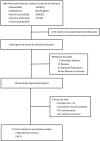Lamivudine plus tenofovir combination therapy versus lamivudine monotherapy for HBV/HIV coinfection: a meta-analysis
- PMID: 30201035
- PMCID: PMC6130076
- DOI: 10.1186/s12985-018-1050-3
Lamivudine plus tenofovir combination therapy versus lamivudine monotherapy for HBV/HIV coinfection: a meta-analysis
Abstract
Background: Currently, there is no consensus on the efficacy and safety of lamivudine (LAM) plus tenofovir disoproxil fumarate (TDF) combination therapy versus lamivudine monotherapy in HBV/HIV coinfected patients.
Methods: A comprehensive literature search was performed in English and Chinese databases. Both relevant dichotomous and continuous variables were extracted, and the combined outcomes were expressed as a risk ratio (RR) or a standard mean difference (SMD).
Results: Eleven eligible studies were included in our analysis. For HBV-relevant outcomes, the proportion of patients with undetectable HBV, the rates of serum alanine aminotransferase (ALT) normalization and hepatitis B e antigen (HBeAg) loss were higher in the combination therapy group than the monotherapy group (RR = 1.42, 95% CI: 1.14-1.76, P = 0.002; RR = 1.36, 95% CI: 1.17-1.58, P < 0.0001; RR = 2.74, 95% CI: 1.20-6.22, P = 0.02). In addition, the rate of HIV RNA-negative conversion was higher in the combination therapy group than the monotherapy group (RR = 1.26, 95% CI: 1.11-1.42, P = 0.0003).
Conclusion: LAM plus TDF combination therapy was more efficacious than LAM monotherapy in HBV/HIV coinfected patients. As time passes, this difference becomes more pronounced.
Keywords: HBV/HIV coinfection; Lamivudine; Tenofovir.
Conflict of interest statement
Ethics approval and consent to participate
not applicable.
Consent for publication
not applicable.
Competing interests
The authors’ declare that they have no competing interests.
Publisher’s Note
Springer Nature remains neutral with regard to jurisdictional claims in published maps and institutional affiliations.
Figures
Similar articles
-
Lamivudine plus tenofovir versus lamivudine plus adefovir for the treatment of hepatitis B virus in HIV-coinfected patients, starting antiretroviral therapy.Indian J Med Microbiol. 2018 Apr-Jun;36(2):217-223. doi: 10.4103/ijmm.IJMM_17_37. Indian J Med Microbiol. 2018. PMID: 30084414 Clinical Trial.
-
Five-year on-treatment efficacy of lamivudine-, tenofovir- and tenofovir + emtricitabine-based HAART in HBV-HIV-coinfected patients.J Viral Hepat. 2012 Nov;19(11):801-10. doi: 10.1111/j.1365-2893.2012.01601.x. Epub 2012 Mar 15. J Viral Hepat. 2012. PMID: 23043387
-
Virological Response to Tenofovir Disoproxil Fumarate in HIV-Positive Patients with Lamivudine-Resistant Hepatitis B Virus Coinfection in an Area Hyperendemic for Hepatitis B Virus Infection.PLoS One. 2016 Dec 29;11(12):e0169228. doi: 10.1371/journal.pone.0169228. eCollection 2016. PLoS One. 2016. PMID: 28033344 Free PMC article.
-
HIV/HBV coinfection in children and antiviral therapy.Expert Rev Anti Infect Ther. 2013 Mar;11(3):251-63. doi: 10.1586/eri.13.2. Expert Rev Anti Infect Ther. 2013. PMID: 23458766 Free PMC article. Review.
-
Efficacy of Tenofovir-Based Combination Therapy versus Tenofovir Monotherapy in Chronic Hepatitis B Patients Presenting with Suboptimal Responses to Pretreatment: A Meta-Analysis.Gastroenterol Res Pract. 2016;2016:7214020. doi: 10.1155/2016/7214020. Epub 2016 Jan 11. Gastroenterol Res Pract. 2016. PMID: 26880896 Free PMC article. Review.
Cited by
-
Recent Advances in Hepatitis B Treatment.Pharmaceuticals (Basel). 2021 May 1;14(5):417. doi: 10.3390/ph14050417. Pharmaceuticals (Basel). 2021. PMID: 34062711 Free PMC article. Review.
-
A long-acting 3TC ProTide nanoformulation suppresses HBV replication in humanized mice.Nanomedicine. 2020 Aug;28:102185. doi: 10.1016/j.nano.2020.102185. Epub 2020 Mar 24. Nanomedicine. 2020. PMID: 32217146 Free PMC article.
-
Long-term virological and serologic responses of chronic hepatitis B virus infection to tenofovir disoproxil fumarate-containing regimens in patients with HIV and hepatitis B coinfection.Hepatol Int. 2019 Jul;13(4):431-439. doi: 10.1007/s12072-019-09953-4. Epub 2019 Jun 8. Hepatol Int. 2019. PMID: 31177505
-
FDA approved drugs with pharmacotherapeutic potential for SARS-CoV-2 (COVID-19) therapy.Drug Resist Updat. 2020 Dec;53:100719. doi: 10.1016/j.drup.2020.100719. Epub 2020 Jul 15. Drug Resist Updat. 2020. PMID: 32717568 Free PMC article. Review.
-
Immunological Efficacy of Tenofovir Disproxil Fumarate-Containing Regimens in Patients With HIV-HBV Coinfection: A Systematic Review and Meta-Analysis.Front Pharmacol. 2019 Sep 12;10:1023. doi: 10.3389/fphar.2019.01023. eCollection 2019. Front Pharmacol. 2019. PMID: 31572195 Free PMC article.
References
-
- Diederich WE, Steuber H. Therapy of viral infections. Topics Med Chem. 2015;2:35–56.
-
- Fischer J. Analogue-based drug discovery. Chemistry International -- Newsmagazine for IUPAC. 2010;32:12–15.
-
- Sharp M, Interpharma D, Sharp M, Interpharma D, Celle L, Cloud S. Sharp M. WHO Model List of Essential Medicines: Interpharma D; 2011.
Publication types
MeSH terms
Substances
Grants and funding
- 2017ZX10202203-007/National Science and Technology Major Project of China/International
- 2017ZX10202203-008/National Science and Technology Major Project of China/International
- cstc2012jjA10064/Natural Science Foundation Project of CQCSTC/International
- cstc2013jcyjA10060/Natural Science Foundation Project of CQCSTC/International
LinkOut - more resources
Full Text Sources
Other Literature Sources
Medical
Research Materials





